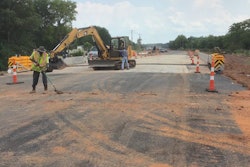 Crews were paving June 2 on Interstate 95 in Henrico County, Virginia, when a pickup truck crashed into a contractor-owned, truck-mounted crash cushion. Photo credit: Virginia DOT Richmond District
Crews were paving June 2 on Interstate 95 in Henrico County, Virginia, when a pickup truck crashed into a contractor-owned, truck-mounted crash cushion. Photo credit: Virginia DOT Richmond DistrictFor the past three years, a safety certification program for the road construction industry has been quietly gaining momentum.
The Safety Certification for Transportation Project Professionals began in 2016 as a response to the hundreds of deaths and tens of thousands of injuries that occur each year in road work zones. Since then, the program has certified 400 transportation construction professionals, has achieved accreditation from the American National Standards Institute and has gained the backing of some heavy-hitters in the road construction industry.

Brad Sant, ARTBA senior vice president of safety and education, says the certification is creating a common denominator for the industry.
“There’s a hope that the contracts will be able to go from state to state and jurisdiction to jurisdiction and having the credential will demonstrate also to the DOT that they’re competent,” Sant says. “Because right now, every time they bid and they win a bid, they have to send in a safety program. It has to be approved, and the requirements are different from state to state.”
Such differing requirements create confusion and inefficiency, he adds. “So the idea of getting a standardized, baseline expectation for the industry of what should be known by a contractor is what a lot of people are excited about.”
Getting ahead of regulations
ARTBA is quick to say that it is not looking to make the certification program a requirement. Instead, part of the goal is to encourage the industry to resolve safety issues in a voluntary, cooperative way rather than waiting on regulations.
“We want the agencies and the contractors to say, ‘Look, we have a problem. Between 140 and 200 workers are dying every year, and we have 700 to 800 motorists dying every year in work zone accidents,’” Sant says.
“So we need to take a greater moral responsibility as an industry, not point fingers and say, ‘Oh, it’s the private sector or its the public sector or whoever.’
“We need to rally around this and say, ‘Yeah, we need to fix this.’
“And that’s what ARTBA did with the certification and said, ‘Enough’s enough, we’ve got to do something different because nothing’s changing.’”
Becoming certified
In developing the certification, which consists of an exam of up to 120 multiple-choice questions, ARTBA targeted transportation project professionals, not safety professionals, says Katie Chimelewski, the association’s director of safety and certification.
“The test is geared toward foremen, supervisors, planners, designers, even an inspector,” Chimelewski says. They will be on the worksite, but safety is not their main job responsibility. The goal is to have everyone from the beginning of the project to the actual construction understand the safety hazards and how to reduce or correct them, she says.
To qualify for certification, candidates must have completed OSHA 10-Hour Construction Outreach Training or equivalent. They also must have at least three years of industry work experience, or two years of experience with a bachelor’s degree in engineering or construction management or with an associate or technical degree in safety.
The exam for the certification tests the candidate’s safety knowledge, which can be obtained from a variety of sources, including from an employer-based or other safety training. The exam was developed by industry executives and safety advocates in a process recognized by ANSI and the International Organization for Standardization (ISO), ARTBA says. Companies involved in the development include Caterpillar and Astec Industries and agencies such as the U.S. Department of Transportation and the Texas DOT.
The 2 ½-hour exam covers such topics as assessing project risk, creating a safety plan, implementing site-specific safety plans, continuing ongoing evaluation of the safety plan and conducting incident investigations. The application and testing fee costs $400.
After passing the exam, ARTBA issues a certificate. The credential is good for three years. This fall, ARTBA will see its first class of those seeking recertification. They can become recertified through professional-development hours or by taking the latest exam.
“So once everybody completes the certification program – it does not matter what position you’re in – you all have the same basic safety knowledge,” Chimelewski says. “You can identify the risks and the hazards on a jobsite, and you would know how to implement some sort of fix or solution and how to mitigate the risks.”
Gaining momentum
The certification got a boost this year when three large transportation construction contractors challenged other contractors to commit to having at least 25 employees earn the credential each year.
Those issuing the challenge are Bob Alger, chairman of Lane Construction and ARTBA; Ross Myers, chairman and CEO of Allan Myers; and David Walls, president and CEO of Austin Industries.
Other construction companies that have certified employees include Barriere, Ranger and Superior. The Texas Department of Transportation has more than 50 employees who are certified.
Chimelewski notes that companies and DOTs around the country are using the program to help employees develop professionally, which can also help retain employees.
Sant says the insurance industry is keeping an eye on the program, with several large insurers participating as subject matter experts and commission members. Sant and others hope the certification could eventually lead to a break on premiums or reduced experience modification rates. But insurers say they will need data showing the certification leads to risk reduction before that could occur.
As the program grows, Sant believes ARTBA will be able to provide that data. He also hopes the industry will see the certification program as a way to improve work zone safety without the need for additional regulations.
“What we always want is for the industry to solve the problem through cooperation, identifying programs and looking at how to mutually resolve them before we get to the regulatory point,” he says. “You do a much better job if you say, ‘What makes this safe?’ as opposed to, ‘How do I comply with the regulations?’”
For more on the program, see the video below:















